COVID-19 pandemic in South Sudan
The COVID-19 pandemic was confirmed to have reached South Sudan on 5 April 2020. The first four confirmed cases were UN workers.[3] As of 27 July, there are 2,313 confirmed cases and 46 deaths due to COVID-19 in South Sudan. As of 23 July, there have been 13,040 tests.[1]
| COVID-19 pandemic in South Sudan | |
|---|---|
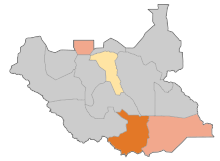 Map of cases by state as of 8 May. Some cases are not shown if their location is unknown
0 cases or no data 1–9 cases 10–49 cases 50–99 cases | |
| Disease | COVID-19 |
| Virus strain | SARS-CoV-2 |
| Location | South Sudan |
| Arrival date | 5 April 2020 (4 months and 2 weeks) |
| Confirmed cases | 2,489[1] [2] |
| Recovered | 1,175 (previously hospitalized)[1] |
Deaths | 47[1] |
Timeline
Prevention efforts
On 14 March, South Sudan suspended flights to countries affected by coronavirus.[4] On 20 March, classes in all schools and universities were suspended until 19 April, and Vice President Hussein Abdelbagi ordered the suspension of sporting, social, political, and religious gatherings for 6 weeks.[5] This was followed on 25 March by a nighttime curfew from 8 p.m. to 6 a.m.[6][7] On 27 March, around 500 people in quarantine from Sudan escaped in Renk, leading to northern Upper Nile State being placed under lockdown for 14 days.[8] From 25 March, after the coronavirus reached Mali, to 5 April 2020, South Sudan was the largest country by area without any confirmed cases of COVID-19.
April 2020
On 5 April, the first case of COVID-19 in the country was confirmed in a 29-year-old patient, a United Nations worker who arrived on 28 February from the Netherlands[6] via Ethiopia.[9] South Sudan thus became the 51st African country (out of 54) to confirm a case.[6] The patient was quarantined at a UN facility and contact tracing efforts were undertaken.
The second case of COVID-19 was confirmed on 7 April; the patient was another female United Nations worker, aged 53, who arrived from Nairobi on 23 March and self-quarantined.[10] The third case on 9 April was also a female United Nations worker who had been in contact with the first patient.[11]
On 9 April, the Ministry of General Education announced it was preparing a distance learning program for primary and secondary school students via radio and television.[12] On 13 April, South Sudan suspended flights and public transportation between the states and between Juba and the states.[13]
Unlike the first cases, the fifth and sixth cases on 23 and 25 April were confirmed to be South Sudanese nationals.[14]
After 28 people tested positive on 28 April, the curfew was extended to be from 7 p.m. to 6 a.m., all restaurants were only allowed to be takeout, and all passenger boda bodas were banned.[15]
A total of 35 patients tested positive in April. All 35 were active cases at the end of the month.[16] Model-based simulations indicate that the 95% confidence interval for the time-varying reproduction number R t has been stable around 1.0 since April.[17]
South Sudan has a population of 14 million people, but only 4 ventilators.[6]
May 2020
Although cases were still increasing, South Sudan began the process of reopening on 7 May. The curfew was decreased to 10 p.m. to 6 a.m., boda bodas were allowed to have one passenger and rickshaws two passengers, if both the driver and the passengers wore face masks, and shops were allowed to reopen with a maximum of five occupants at a time.[18] On 12 May, airports were reopened for local, regional, and international flights.[19]
On 14 May, South Sudan reported its first death from COVID-19.[20]
On 18 May, First Vice President Riek Machar announced he and his wife, Angelina Teny, had tested positive for the virus.[21] On 19 May 2020, Information Minister Michael Makue Loweth and all members of the nation's 15-member coronavirus task force tested positive for COVID-19.[22] Another Vice President, Hussein Abdelbagi, the head of the COVID-19 Task Force, tested positive on May 27.[23] Vice President James Wani Igga announced he had tested positive on May 30.[24]
There were 959 new cases in May, raising the total number of confirmed cases to 994. Ten persons died in May while six patients recovered, leaving 978 active cases at the end of the month.[25]
June 2020
In June there were 1013 new cases, bringing the total number of confirmed cases to 2007. The death toll rose by 28 to 38. The number of recovered patients increased to 279, leaving 1690 active cases at the end of the month.[26]
July 2020
Towards the middle of July, business owners in Aweil reported that the pandemic had caused food prices to rise and that the number of customers in restaurants had decreased.[27] On July 24, officials in Eastern Equatoria State reported an increase in the number of teenage pregnancies during the lockdown, which could lead to more school dropouts.[28]
There were 345 new cases in July, bringing the total number of confirmed cases to 2352. The death toll rose by eight to 46. The number of recovered patients increased to 1205, leaving 1101 active cases at the end of the month.[29]
Data
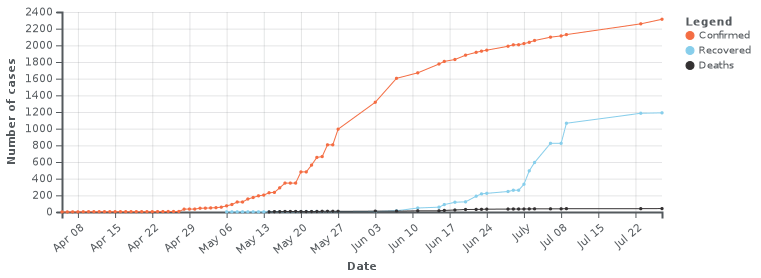

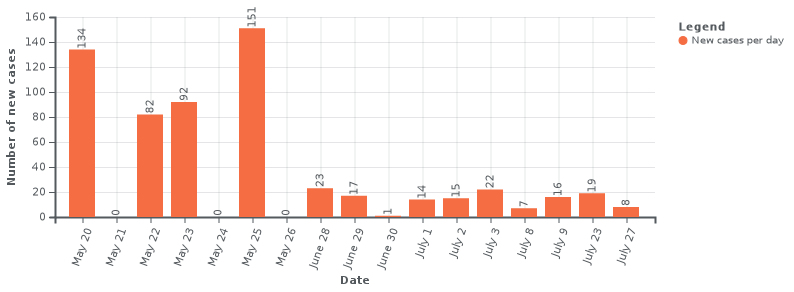
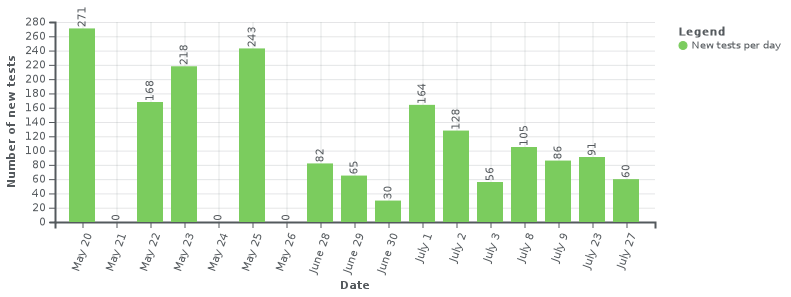
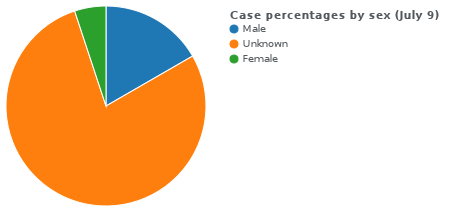
References
- "Covid-19: South Sudan records 19 new cases". Radio Tamazuj. Retrieved 23 July 2020.
- "WHO Coronavirus South Sudan". WHO. Retrieved 17 August 2020.
- "Briefing: What's behind South Sudan's COVID-19 inspired UN-backlash". The New Humanitarian. 10 April 2020. Retrieved 1 July 2020.
- "South Sudan halts flights to countries affected by coronavirus". Radio Tamazuj. Archived from the original on 16 March 2020. Retrieved 5 April 2020.
- "South Sudan closes schools, universities amid coronavirus fears". Radio Tamazuj. Archived from the original on 21 March 2020. Retrieved 5 April 2020.
- Mayra Ajack, South Sudan 51st of 54 African nations to report virus case, Associated Press (5 April 2020).
- "South Sudan imposes nighttime curfew over coronavirus". Radio Tamazuj. Archived from the original on 26 March 2020. Retrieved 5 April 2020.
- "Northern Upper Nile under lockdown after citizens escaped from quarantine". Radio Tamazuj. Archived from the original on 28 March 2020. Retrieved 5 April 2020.
- "South Sudan confirms first case of coronavirus". Reuters. 5 April 2020. Retrieved 5 April 2020.
- "South Sudan confirms second case of coronavirus". Radio Tamazuj. Retrieved 8 April 2020.
- "South Sudan records third case of COVID-19". Radio Tamazuj. Retrieved 9 April 2020.
- "Education ministry to launch distance learning for students". Radio Tamazuj. Retrieved 13 April 2020.
- "South Sudan suspends interstate travels over COVID-19". Radio Tamazuj. Retrieved 14 April 2020.
- "South Sudan records its sixth coronavirus case". Radio Tamazuj. Retrieved 26 April 2020.
- "COVID-19: South Sudan reviews curfew as cases rise to 34". Radio Tamazuj. Retrieved 29 April 2020.
- "Coronavirus disease (COVID-19) situation report 102" (PDF). World Health Organization. 1 May 2020. p. 6. Retrieved 21 July 2020.
- Future scenarios of the healthcare burden of COVID-19 in low- or middle-income countries, MRC Centre for Global Infectious Disease Analysis at Imperial College London.
- "South Sudan loosens restrictions even as coronavirus cases increase". Radio Tamazuj. Retrieved 8 May 2020.
- "South Sudan reopens airports amid rise in COVID-19 cases". Radio Tamazuj. Retrieved 13 May 2020.
- "South Sudan records first COVID-19 death as cases rise". Radio Tamazuj. Retrieved 14 May 2020.
- "Dr. Riek Machar and wife test positive for COVID-19". Eye Radio. 18 May 2020. Retrieved 18 May 2020.
- "South Sudan Officials, COVID Task Force Test Positive for Virus". VOA. 19 May 2020. Retrieved 28 May 2020.
- "South Sudan confirms 18 new COVID-19 cases". Radio Tamazuj. Retrieved 15 June 2020.
- "VP Igga tests positive for COVID-19". Radio Tamazuj. Retrieved 30 May 2020.
- "Coronavirus disease (COVID-19) situation report 133" (PDF). World Health Organization. 1 June 2020. p. 6. Retrieved 21 July 2020.
- "Coronavirus disease (COVID-19) situation report 163" (PDF). World Health Organization. 1 July 2020. p. 6. Retrieved 21 July 2020.
- "COVID-19 affects women businesses in Aweil". Radio Tamazuj. Retrieved 23 July 2020.
- "Covid-19: Eastern Equatoria says schoolgirl pregnancies increasing due to lockdown". Radio Tamazuj. Retrieved 30 July 2020.
- "Coronavirus disease (COVID-19) situation report 194" (PDF). World Health Organization. 1 August 2020. p. 5. Retrieved 2 August 2020.